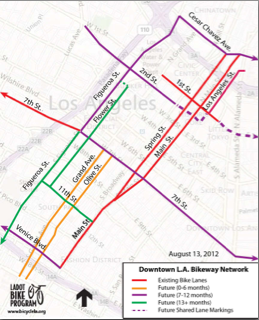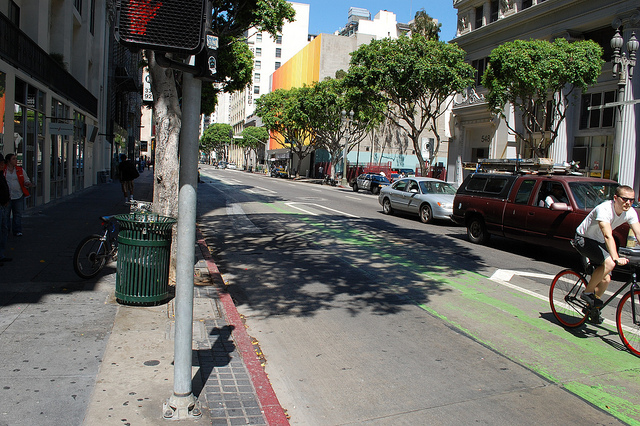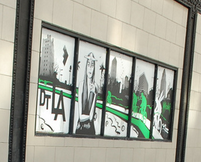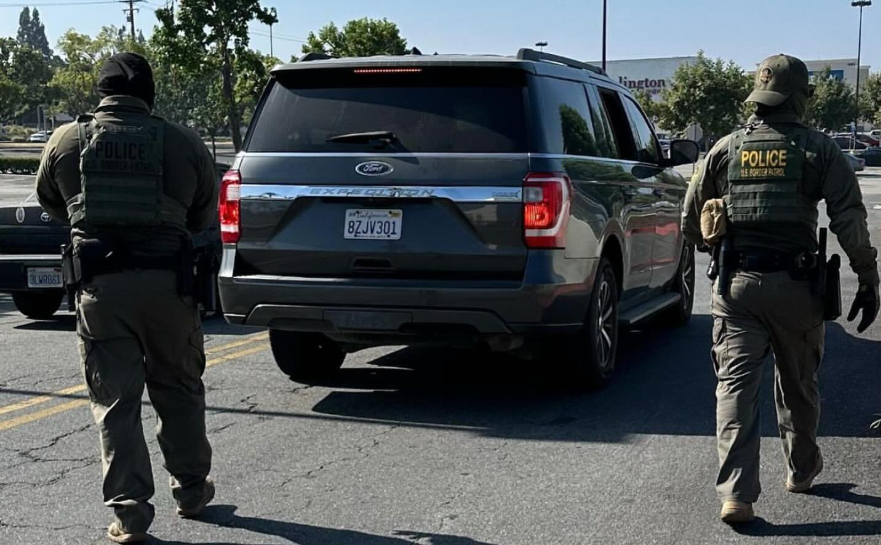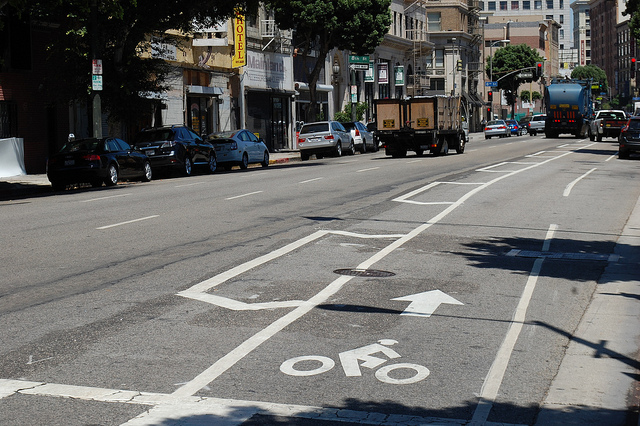
In 2011, the City of Los Angeles passed a new Bike Plan which included a “5 year bike network implementation plan.” The implementation plan focued on a handful of “core” areas to focus the bulk of the new bike facilities. One of those areas is Downtown Los Angeles. A year and a half later, checks in on how Downtown Los Angeles has changed in the past year and a half and what is in store in the coming years.
Much of the development downtown can be contributed to local volunteers and advocates who pushed for the improvement of their streets. Valerie Watson, a member of the board of directors for the Downtown LA Neighborhood Council (DLANC), has been involved with a number of local neighborhood initiatives to improve the quality of the streets downtown.
“There’s so many amazing talented design professionals that work downtown or live downtown. I thought about a year ago one thing we would do is get all these people together and come up with ideas on what we might want to do to tackle the perception of streets downtown as places for people, not freeways,” she said in an interview. The downtown bike network initiative was one such project.
Watson detailed how the DLANC invited Los Angeles Department of Transportation (LADOT) to come to a meeting and speak about developments in local neighborhoods, also giving them a chance to be involved in these decisions. Once the DLANC saw what LADOT had in mind, they began to offer their help with the projects.
“We wanted to give them more honest feedback from a resident’s perspective, from a business owner’s perspective,” she said. “We really tried to capture all the needs that we were hearing from people.”
In order to ensure residents and business owners had their say, Watson worked together with LADOT and the Los Angeles County Bike Coalition (LACBC) to gather feedback and support from local communities. She created a flyer explaining the coming changes and immediately reached out to the LACBC and LADOT to get the word out. The groups when door to door along Spring Street, making sure residents understood what changes were coming. Based on that, the groups compiled questions and got answers from LADOT, creating a second FAQ flyer for the neighborhoods.
“There’s a lot of resistance to change in general, and people kind of react when they don’t feel like they’ve been engaged and involved in this decision making,” said Eric Bruins, Planning and Policy Director for the LACBC.
“It was my intention that it wouldn’t be like other neighborhoods in L.A., where things turned sour,” explained Watson. “Those people have a right to be concerned, they have a right to understand what’s coming to the neighborhood. I just don’t think the city is equipped, with this current economic climate, to go out there and do this kind of outreach. I think [our efforts] made all the difference. We addressed all those concerns before [the bike lane] went in.”
And so the Spring Street Green Buffered Bike Lane was painted. Ridership increased on the street by 52% overall, with a 250% increase of cyclists on the weekends, and a 161% increase in female ridership, according to the LACBC 2011 City of Los Angeles Bicycle and Pedestrian Count Report. While explicit feedback has been sparse, Bruins has characterized the overall response as positive.
“It’s amazing how quiet it is after these sorts of projects go in,” he said.” “[People think] ‘This is a transformation here, it’s gonna make everything awesome,’ and then you just don’t hear anything because it just becomes the new normal.”
So far, the City of Los Angeles has built new bike lanes along Main Street and Spring Street, as well as parts of 1st and 7th Streets. The plan for the next 6 months is to install new lanes down Grand Avenue and Olive Street. These new lanes are meant to join with lane expansions along Venice Avenue and 7th Street, which, along with 2nd Street, parts of Figueroa, and Cesar Chavez Avenue, are slated for the next 7 to 12 months. Finally, in the next year and beyond, expect to see the continuation of the bike lanes on Figueroa, as well Flower Street and 11th Street.
“We have to be prepared, because I think there is a greater potential for backlash. We’re already starting to see it a little bit,” said Bruins, speaking about future bike lanes. With heavy traffic on streets such as Venice and 7th. “It’s important to have bike facilities because it means more options when others are restricted, but it also means every inch of pavement is contested as well.”
In order to confront such opposition, the LACBC has created a neighborhood bike ambassador program, a grass roots network of cyclists who explain the projects and their importance.
“Cyclists need to start presenting themselves to non-cyclists and working together on helping us move forward with bike infrastructure in the city,” said Bruins.
“This story of the downtown bike network is a story that can be a model for other neighborhoods,” said Watson. “We’re inspiring LADOT to do a little bit more. I hope it sticks and I think it will. I think they see now what you can do when you get into the fine grain of a neighborhood.”
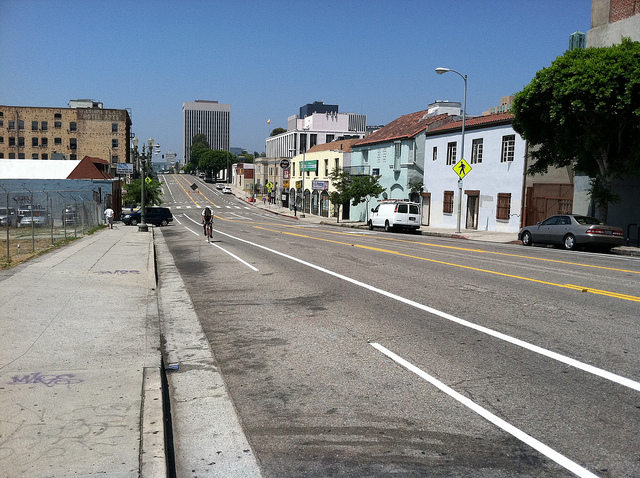
In order to see the bike lanes in action, I walked the bike lane network earlier this month with Damien Newton, along Main Street and Spring Street. While we didn’t see many cyclists using the bike lanes in the intense summer heat, many cyclists were enthusiastic about the bike lane network expansions.
Manny Sosa, bike mechanic at El Maestro Bicycle Shop on Main Street, has seen a definite increase in business over the past couple of months. “We have more bike traffic now, and we just got the lane on Main, right in front of the shop,” he said, speaking to the increase in business and riders. “I actually feel safer, we have a space to ride now, and I think cars respect that,” he said.
Jeffrey, a downtown cyclist for over a year, however, said he still didn’t feel entirely safe in the new lanes, especially where cars frequently turn and cut into the bike lane. “I ride in the bike lane most of the time, but if somebody’s cutting in front of me, you know, I have to get into the car’s lane to avoid them.”
Finally, we talked to Rodney Masjedi, the owner of DTLA Bikes on Broadway. “A big reason why people tell me they don’t want to ride is because they’re scared, you know, coming back in traffic. They want to beat the rush hour, but if there’s no bike lanes, it makes it kind of hectic to weave in and out of cars.”
“[The new lanes are] Awesome. Legislation for getting more bike friendly can help everyone riding their bikes feel safer in LA,” he said.
In the future, advocates like the DLANC and LACBC are pushing to further expand LA’s offerings to bicyclists.
“Hopefully we can get to a point where people don't have to think about bike infrastructure because it's just assumed that it's there and it works,” said Bruin.
Do you have any stories about riding downtown or reactions to the bike network? Feel free to let us know in the comments section.
